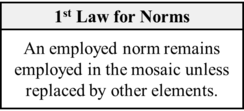Difference between revisions of "Mechanism of Scientific Inertia for Normative Theories"
| (One intermediate revision by the same user not shown) | |||
| Line 5: | Line 5: | ||
|Inherited From=Mechanism of Scientific Inertia for Epistemic Elements | |Inherited From=Mechanism of Scientific Inertia for Epistemic Elements | ||
|Heritable=No | |Heritable=No | ||
| − | |Question Text Formula= | + | |Question Text Formula=What makes the <subjects> of an agent's mosaic continue to remain in the mosaic? |
|Question Title Formula=Mechanism of Scientific Inertia for <Subjects> | |Question Title Formula=Mechanism of Scientific Inertia for <Subjects> | ||
| − | |Question= | + | |Question= |
| − | |Question Title= | + | |Question Title= |
|Predicate=mechanism of inertia | |Predicate=mechanism of inertia | ||
|Object Type=Text | |Object Type=Text | ||
| Line 26: | Line 26: | ||
|Current View= | |Current View= | ||
|Parent Topic= | |Parent Topic= | ||
| − | |Sorting Order= | + | |Sorting Order=120 |
|Page Status=Stub | |Page Status=Stub | ||
| − | |Editor Notes= | + | |Editor Notes= |
}} | }} | ||
{{Acceptance Record | {{Acceptance Record | ||
Latest revision as of 12:16, 20 June 2024
What makes the normative theories of an agent's mosaic continue to remain in the mosaic?
It is important to understand what makes a norm that is already part of an agent's mosaic stay in that mosaic. In other words, it is important to know under what conditions such an inertia is possible
In the scientonomic context, this question was first formulated by Aayu Pandey in 2023. The question is currently accepted as a legitimate topic for discussion by Scientonomy community.
In Scientonomy, the accepted answer to the question is:
- An employed norm remains employed in the mosaic unless replaced by other elements.
Contents
Scientonomic History
Acceptance Record of the Question
| Community | Accepted From | Acceptance Indicators | Still Accepted | Accepted Until | Rejection Indicators |
|---|---|---|---|---|---|
| Scientonomy | 28 December 2023 | The publication of Pandey's paper where an answer to this question is suggested is an indication that the question itself is accepted. | Yes |
All Direct Answers
| Theory | Formulation | Formulated In |
|---|---|---|
| The First Law for Norms (Barseghyan-Pandey-2023) | An employed norm remains employed in the mosaic unless replaced by other elements. | 2023 |
If a direct answer to this question is missing, please click here to add it.
Accepted Direct Answers
| Community | Theory | Formulation | Accepted From | Accepted Until |
|---|---|---|---|---|
| Scientonomy | The First Law for Norms (Barseghyan-Pandey-2023) | An employed norm remains employed in the mosaic unless replaced by other elements. | 22 February 2024 |
Suggested Modifications
| Modification | Community | Date Suggested | Summary | Date Assessed | Verdict | Verdict Rationale |
|---|---|---|---|---|---|---|
| Sciento-2023-0002 | Scientonomy | 28 December 2023 | Accept new formulations of the first law for theories, norms, and questions that are in tune with the formulation of the first law. Also accept new formulations of the respective rejection theorems - theory rejection, norm rejection, and question rejection. | 22 January 2024 | Accepted | During the 2024 workshop, the bulk of the discussion centered around the inclusion of the first law for norms and norm rejection theorem in the set of formulations to be accepted. Paul Patton contended that norm employment in general had not been demonstrated to be lawful beyond method employment, and our basic formulations should instead concern norm acceptance, which is patently lawful. He argued that the formulations should be modified to pertain either to methods only or to norm acceptance. It was decided that if the community were to remain uncomfortable with accepting Pandey’s new formulations, a revote would likely also need to be taken on Rawleigh’s Sciento-2022-0002, given that the issue of norm employment was also highlighted in discussions of that modification. After extensive discussion, Barseghyan suggested that the first law for norms would only apply to situations where behavior was norm-guided to begin with, which would skirt the difficulty that faces even behavioural psychologists of determining whether human behaviour in general is lawful. The majority of the community was comfortable with this workaround, and the modification was ultimately accepted with over 2/3rds majority assenting, with 11/14 votes to accept (although 1 voter voted to reject the modification and 2 voted to keep it open). |
Current View
In Scientonomy, the accepted answer to the question is The First Law for Norms (Barseghyan-Pandey-2023).
The First Law for Norms (Barseghyan-Pandey-2023) states: "An employed norm remains employed in the mosaic unless replaced by other elements."
Unlike Barseghyan's initial formulation of the first law for methods, Pandey's formulation accomplishes two things. First, it applies to norms of all types rather than merely to methods. Second, it allows for norms to be replaced by elements of any type, not merely by other norms.1pp. 28-29
Related Topics
This question is a subquestion of Mechanism of Scientific Inertia for Theories.
It has the following sub-topic(s):
References
- ^ Pandey, Aayu. (2023) Dilemma of the First Law. Scientonomy 5, 25-46. Retrieved from https://scientojournal.com/index.php/scientonomy/article/view/42258.
